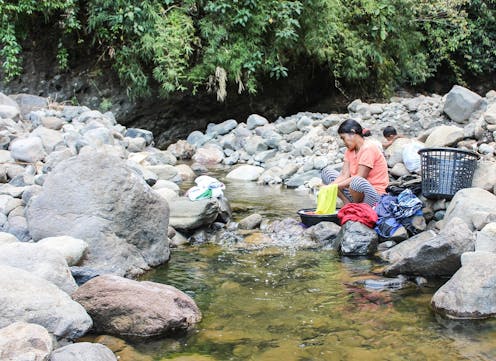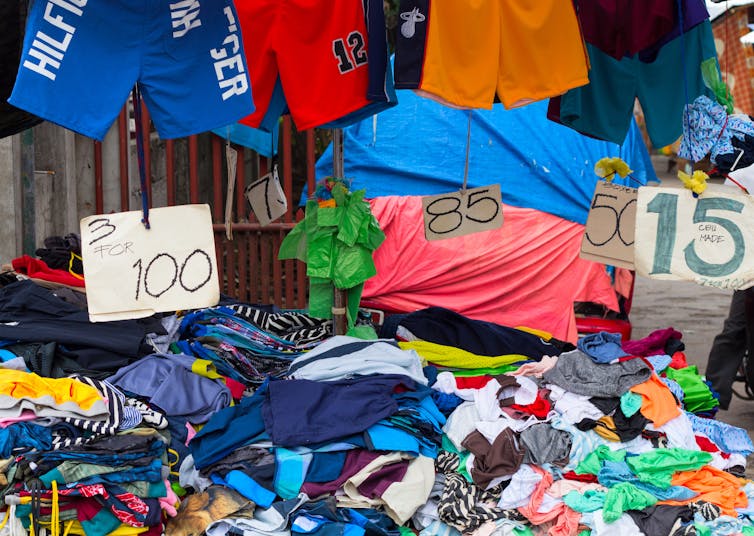
Between 6,500 and 87,000 tonnes of microfibres are shed during domestic laundering every year in the UK. Many of these minuscule fibres end up in rivers and oceans, with devastating consequences for aquatic animals and environments.
As a result, environmental advocacy groups in the UK, EU and North America are campaigning for legislation to mandate microfibre-catching filters for all new washing machines.
But microfibre pollution isn’t limited to machine washing. Our new research shows that washing clothing by hand can shed just as many microfibres as laundry washed in a machine.
This is an issue. More than half of the global population doesn’t have regular access to a washing machine and so launder “off-grid”, such as by hand. Hand washing laundry often involves a lot of scrubbing and abrasion that sheds fibres. Wastewater from hand laundering may flow directly into rivers or onto concrete and stone “laundry decks”, bypassing wastewater treatment facilities even where such facilities are available.
Resolving the microfibre pollution problem necessitates more than just installing washing machine filters. It requires changes in how textiles are designed, manufactured and traded on a global scale.
Fibres shed from hand laundry
Scientific research into fibre shedding often overlooks people that hand launder their clothes, with the predominant focus being on the fibres shed by conventional electric washing machines. Although scientists from countries where many people wash by hand have observed that these methods result in fibre shedding, they have seldom received the necessary support to measure or compare the quantity of fibres shed.
Our research was conducted with colleagues from Isabela State University in the Philippines, Wollongong University in Australia and seven other universities across the UK. We held a workshop and observed hand laundering practices in the Cagayan River Valley in the northern Philippines. We then replicated the hand laundering techniques demonstrated by the local community within a laboratory.
Our experiments measured the fibres shed from both pre-washed and brand-new 100% polyester trousers purchased from a UK high street store. These trousers closely resembled the polyester clothing we found in markets in the Philippines and the garments we observed being hand laundered there.
We found that hand washing these trousers using a plastic scrub brush led to fibre shedding levels of between 6,499 and 64,500 individual fibres per garment. This is comparable to the levels reported for machine laundering. It is evident that hand laundering is not necessarily gentler on textiles than machine laundry.
Measuring ‘sheddability’
People who hand wash their clothes employ various techniques. These are based on the textiles they are washing and the purpose an item of clothing serves. Clothing that is covered in dust or mud, like garments worn for farm work, may require vigorous scrubbing.
Our research could not recreate all of the ways people launder by hand. We were also unable to explore the impact of every textile variable on fibre shedding, including colouration method, dye type, specific knit or weave structure, and mechanical or chemical finishing.
Among the variables we did examine, our results demonstrated that the structure of the textiles had a more pronounced effect on fibre shedding than the type of fibre itself. Fibre type had no significant influence on shedding. Notably, woven textiles shed fewer fibres compared to their knitted counterparts.
It’s not just synthetic textiles that shed problematic fibres. Plant-based textiles like cotton and animal-based textiles such as wool shed fibres in similar quantities to plastic fibres. Some research even suggests that cellulose-based fibres such as cotton may impose comparable, if not more severe, consequences on organisms that ingest them when compared to synthetic microfibres.
Despite often being marketed as “biodegradable”, cotton fibres undergo modifications for use in the textile industry that alter the structure of the cellulose they are composed of. Most cottons also have chemical dyes and finishes added during processing.
As a result, cotton textile fibres do not readily biodegrade in natural surroundings. And any degradation that does occur will probably release chemicals from their production into the environment. This holds true regardless of the laundering method used for the textiles.
Read more: 'Plastic-free' fashion is not as clean or green as it seems
Solving the microfibre problem
Solving the issue of textile fibre shedding is complex. There is a massive global trade in used clothing, worth about US$5 billion (£4.1 billion) per year. Even when care labels and fashion designers have considered electric machine washing, potential washing machine filters and wastewater treatment, the export of used clothing takes these textiles away from that established infrastructure.
But the people we observed hand washing clothing need the affordable and durable work attire that this used clothing trade provides. This means that, to address textile fibre shedding, we require a complete rethink not only of the ways we launder our clothes, but of how clothing is made.
The fundamental problem lies not in the secondhand clothing trade, but in the design of textiles themselves. We could make headway in tackling the microfibre issue by designing low-shed fabrics to make garments that can better withstand the rigours of hand washing. Another approach is the development of new truly biodegradable fibres that will break down naturally in the environment.

In the meantime, those who pride themselves on avoiding synthetic fabrics should recognise that the microfibre problem extends beyond the materials we wear. Textile marketing should not greenwash by conflating “natural” and “biodegradable”. And relying on washing machine filters alone will not solve the problem of microfibre shedding.

Don’t have time to read about climate change as much as you’d like?
Get a weekly roundup in your inbox instead. Every Wednesday, The Conversation’s environment editor writes Imagine, a short email that goes a little deeper into just one climate issue. Join the 20,000+ readers who’ve subscribed so far.
Deirdre McKay receives funding from the British Academy, the Leverhulme Trust, and UKRI via the Arts and Humanities Research Council and Global Challenges Research Fund.
Kelly Sheridan receives funding from UKRI (NERC / AHRC / Innovate UK) via their Circular Fashion and Textiles Network Plus funding. In addition to Northumbria University she also works for The Microfibre Consortium.
Thomas Stanton receives funding from the AXA Research Fund and UKRI (NERC / AHRC / Innovate UK) via their Circular Fashion and Textiles Network Plus funding.
This article was originally published on The Conversation. Read the original article.







